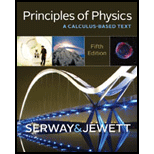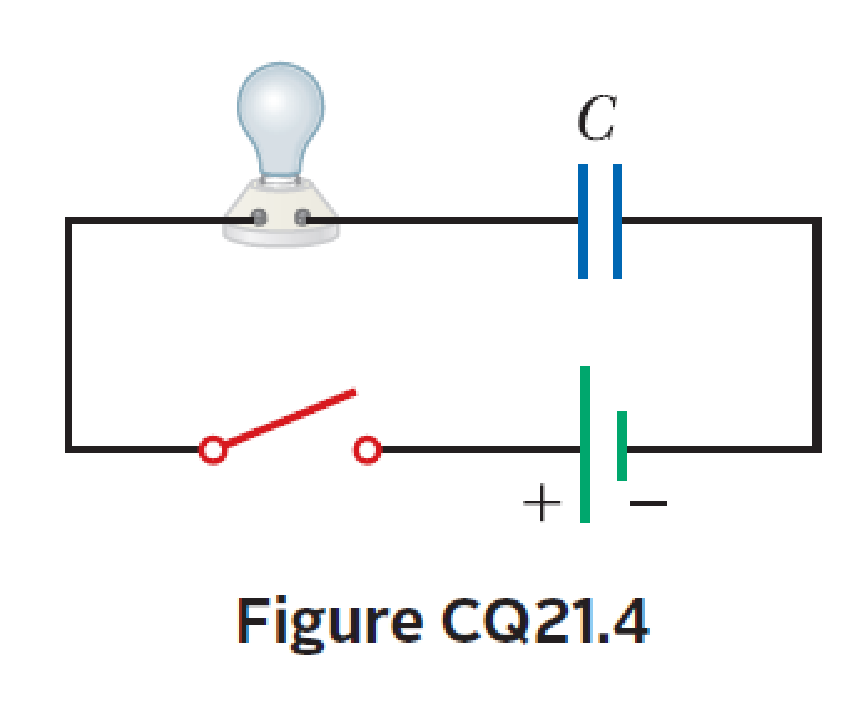
Principles of Physics: A Calculus-Based Text
5th Edition
ISBN: 9781133104261
Author: Raymond A. Serway, John W. Jewett
Publisher: Cengage Learning
expand_more
expand_more
format_list_bulleted
Textbook Question
Chapter 21, Problem 4CQ
Referring to Figure CQ21.4, describe what happens to the light-bulb after the switch is closed. Assume the capacitor has a large capacitance and is initially uncharged. Also assume the light illuminates when connected directly across the battery terminals.

Expert Solution & Answer
Want to see the full answer?
Check out a sample textbook solution
Students have asked these similar questions
d
need help with the one i got wrong
Identify which of the following vectors are parallel to A.
Vector
Vector A
70°
60°
20°
AAZA!
30°
20°
20°
70°
20°
20°
70°
20°
Chapter 21 Solutions
Principles of Physics: A Calculus-Based Text
Ch. 21.1 - Consider positive and negative charges moving...Ch. 21.2 - Prob. 21.2QQCh. 21.2 - When does an incandescent lightbulb carry more...Ch. 21.5 - For the two incandescent lightbulbs shown in...Ch. 21.7 - Prob. 21.5QQCh. 21.7 - With the switch in the circuit of Figure 21.18a...Ch. 21.7 - Prob. 21.7QQCh. 21.9 - Consider the circuit in Figure 21.29 and assume...Ch. 21 - If the terminals of a battery with zero internal...Ch. 21 - Wire B has twice the length and twice the radius...
Ch. 21 - The current-versus-voltage behavior of a certain...Ch. 21 - Prob. 4OQCh. 21 - A potential difference of 1.00 V is maintained...Ch. 21 - Prob. 6OQCh. 21 - A metal wire of resistance R is cut into three...Ch. 21 - The terminals of a battery are connected across...Ch. 21 - Prob. 9OQCh. 21 - Two conducting wires A and B of the same length...Ch. 21 - When resistors with different resistances are...Ch. 21 - When operating on a 120-V circuit, an electric...Ch. 21 - Prob. 13OQCh. 21 - Prob. 14OQCh. 21 - In the circuit shown in Figure OQ21.15, each...Ch. 21 - Prob. 1CQCh. 21 - Prob. 2CQCh. 21 - Prob. 3CQCh. 21 - Referring to Figure CQ21.4, describe what happens...Ch. 21 - When the potential difference across a certain...Ch. 21 - Use the atomic theory of matter to explain why the...Ch. 21 - Prob. 7CQCh. 21 - (a) What advantage does 120-V operation offer over...Ch. 21 - Prob. 9CQCh. 21 - Prob. 10CQCh. 21 - If you were to design an electric heater using...Ch. 21 - Prob. 12CQCh. 21 - Prob. 13CQCh. 21 - Prob. 14CQCh. 21 - Why is it possible for a bird to sit on a...Ch. 21 - Prob. 1PCh. 21 - Prob. 2PCh. 21 - The quantity of charge q (in coulombs) that has...Ch. 21 - Prob. 4PCh. 21 - Prob. 5PCh. 21 - Figure P21.6 represents a section of a conductor...Ch. 21 - Prob. 7PCh. 21 - A 0.900-V potential difference is maintained...Ch. 21 - Prob. 9PCh. 21 - A lightbulb has a resistance of 240 when...Ch. 21 - Prob. 11PCh. 21 - Prob. 12PCh. 21 - While taking photographs in Death Valley on a day...Ch. 21 - Prob. 14PCh. 21 - If the current carried by a conductor is doubled,...Ch. 21 - Prob. 16PCh. 21 - Prob. 17PCh. 21 - Prob. 18PCh. 21 - Prob. 19PCh. 21 - Prob. 20PCh. 21 - Prob. 21PCh. 21 - Prob. 22PCh. 21 - Prob. 23PCh. 21 - Prob. 24PCh. 21 - A 100-W lightbulb connected to a 120-V source...Ch. 21 - Prob. 26PCh. 21 - Prob. 27PCh. 21 - Prob. 28PCh. 21 - A toaster is rated at 600 W when connected to a...Ch. 21 - Prob. 30PCh. 21 - Prob. 31PCh. 21 - Review. A well-insulated electric water heater...Ch. 21 - A battery has an emf of 15.0 V. The terminal...Ch. 21 - Two 1.50-V batterieswith their positive terminals...Ch. 21 - An automobile battery has an emf of 12.6 V and an...Ch. 21 - Prob. 36PCh. 21 - Prob. 37PCh. 21 - Prob. 38PCh. 21 - Consider the circuit shown in Figure P21.39. Find...Ch. 21 - Four resistors are connected to a battery as shown...Ch. 21 - Three 100- resistors are connected as shown in...Ch. 21 - Prob. 42PCh. 21 - Calculate the power delivered to each resistor in...Ch. 21 - Prob. 44PCh. 21 - The ammeter shown in Figure P21.45 reads 2.00 A....Ch. 21 - Prob. 46PCh. 21 - The circuit shown in Figure P21.47 is connected...Ch. 21 - In Figure P21.47, show how to add just enough...Ch. 21 - Taking R = 1.00 k and = 250 V in Figure P21.49,...Ch. 21 - For the circuit shown in Figure P21.50, we wish to...Ch. 21 - In the circuit of Figure P21.51, determine (a) the...Ch. 21 - Jumper cables are connected from a fresh battery...Ch. 21 - Prob. 53PCh. 21 - Prob. 54PCh. 21 - Prob. 55PCh. 21 - Prob. 56PCh. 21 - In the circuit of Figure P21.57, the switch S has...Ch. 21 - Prob. 58PCh. 21 - The circuit in Figure P21.59 has been connected...Ch. 21 - Assume that global lightning on the Earth...Ch. 21 - Prob. 61PCh. 21 - Prob. 62PCh. 21 - Prob. 63PCh. 21 - Prob. 64PCh. 21 - Prob. 65PCh. 21 - An oceanographer is studying how the ion...Ch. 21 - The values of the components in a simple series RC...Ch. 21 - Prob. 68PCh. 21 - Prob. 69PCh. 21 - Prob. 70PCh. 21 - The student engineer of a campus radio station...Ch. 21 - Prob. 72PCh. 21 - A battery has an emf and internal resistance r. A...Ch. 21 - Prob. 74PCh. 21 - Prob. 75PCh. 21 - Prob. 76PCh. 21 - Prob. 77P
Knowledge Booster
Learn more about
Need a deep-dive on the concept behind this application? Look no further. Learn more about this topic, physics and related others by exploring similar questions and additional content below.Similar questions
- 3aarrow_forward44 please help with the this.arrow_forward4a Which of the following values COULD NOT be a magnitude? Choose all that apply. 626 0 -0.806 8.63 -48.5 72 131 156 4b Px = -1248 & Py = 261. Determine P.P = Qx = -1540 & Qy = 375. Determine Q.Q = 4c. T = 1105 & Ty = 425. Determine the two possible values for Tx. 4d. Uy = -38. Which of the following COULD NOT be the value of U? Choose all that apply. 10 70 72 31 47 0 75 38 4e. R has a magnitude of 165. Which of the following COULD be Rx? Choose all that apply. 165 -171 155 0 -156 -165 172 -130arrow_forward
arrow_back_ios
SEE MORE QUESTIONS
arrow_forward_ios
Recommended textbooks for you
 Principles of Physics: A Calculus-Based TextPhysicsISBN:9781133104261Author:Raymond A. Serway, John W. JewettPublisher:Cengage Learning
Principles of Physics: A Calculus-Based TextPhysicsISBN:9781133104261Author:Raymond A. Serway, John W. JewettPublisher:Cengage Learning Physics for Scientists and Engineers: Foundations...PhysicsISBN:9781133939146Author:Katz, Debora M.Publisher:Cengage Learning
Physics for Scientists and Engineers: Foundations...PhysicsISBN:9781133939146Author:Katz, Debora M.Publisher:Cengage Learning
 Physics for Scientists and Engineers, Technology ...PhysicsISBN:9781305116399Author:Raymond A. Serway, John W. JewettPublisher:Cengage Learning
Physics for Scientists and Engineers, Technology ...PhysicsISBN:9781305116399Author:Raymond A. Serway, John W. JewettPublisher:Cengage Learning Physics for Scientists and EngineersPhysicsISBN:9781337553278Author:Raymond A. Serway, John W. JewettPublisher:Cengage Learning
Physics for Scientists and EngineersPhysicsISBN:9781337553278Author:Raymond A. Serway, John W. JewettPublisher:Cengage Learning Physics for Scientists and Engineers with Modern ...PhysicsISBN:9781337553292Author:Raymond A. Serway, John W. JewettPublisher:Cengage Learning
Physics for Scientists and Engineers with Modern ...PhysicsISBN:9781337553292Author:Raymond A. Serway, John W. JewettPublisher:Cengage Learning

Principles of Physics: A Calculus-Based Text
Physics
ISBN:9781133104261
Author:Raymond A. Serway, John W. Jewett
Publisher:Cengage Learning

Physics for Scientists and Engineers: Foundations...
Physics
ISBN:9781133939146
Author:Katz, Debora M.
Publisher:Cengage Learning


Physics for Scientists and Engineers, Technology ...
Physics
ISBN:9781305116399
Author:Raymond A. Serway, John W. Jewett
Publisher:Cengage Learning

Physics for Scientists and Engineers
Physics
ISBN:9781337553278
Author:Raymond A. Serway, John W. Jewett
Publisher:Cengage Learning

Physics for Scientists and Engineers with Modern ...
Physics
ISBN:9781337553292
Author:Raymond A. Serway, John W. Jewett
Publisher:Cengage Learning
DC Series circuits explained - The basics working principle; Author: The Engineering Mindset;https://www.youtube.com/watch?v=VV6tZ3Aqfuc;License: Standard YouTube License, CC-BY